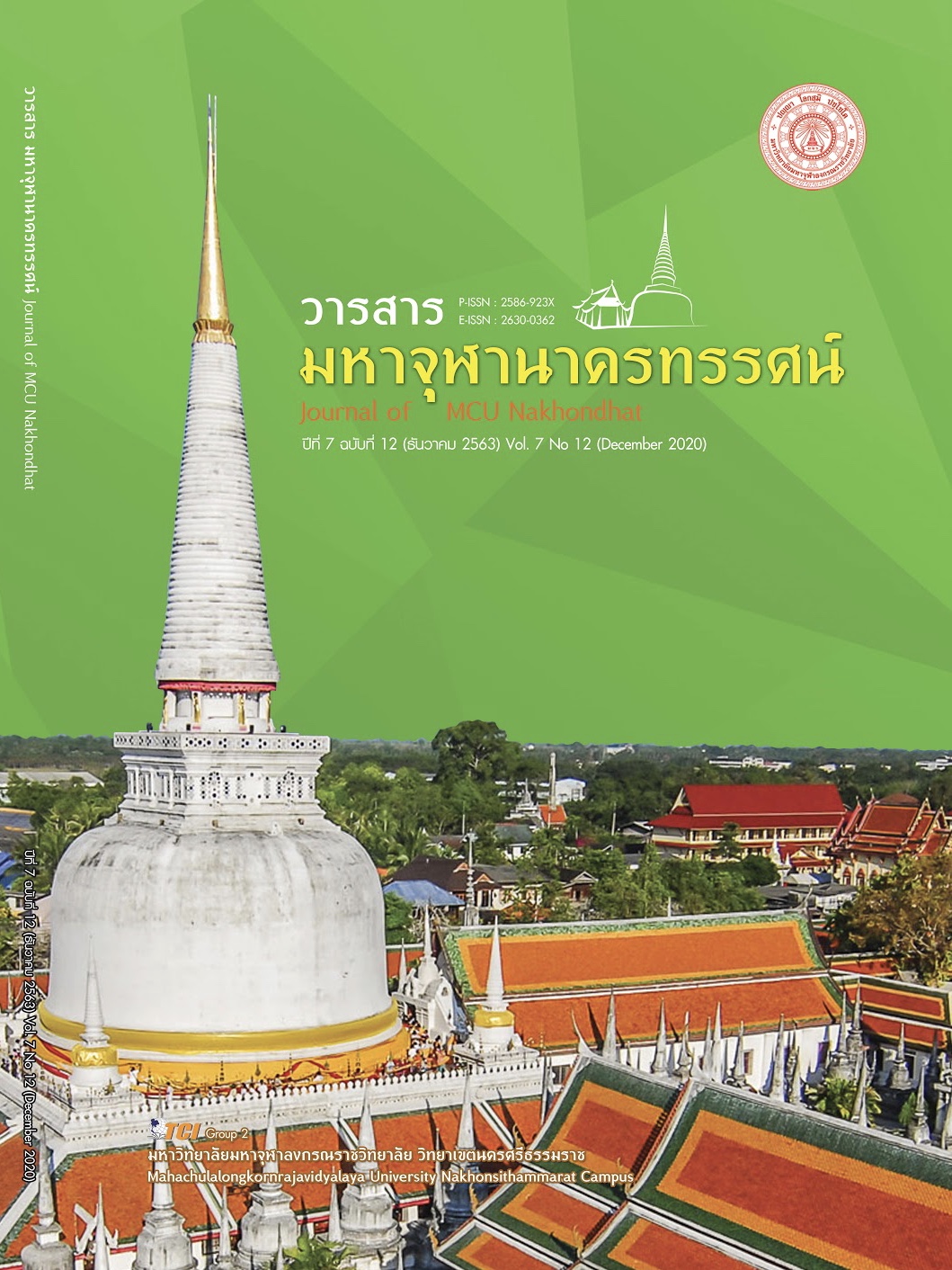THE ECCLESIASTES’ VIEW TOWARDS RECONCILIATION FOR PEACEFUL SOCIETY IN SOUTHERN REGION
Main Article Content
Abstract
The Objectives of this research article were 1) to study the ecclesiastes’ view towards reconciliation for peaceful society in Southern region. 2) to study the suggestion on the way to build up the reconciliation for peaceful society in Southern region, this research article is quantitative research. The populations were composed of ecclesiasts and moral teaching monks in school in specific area of Southern region, there are 420 persons, sample size was 201 persons according to Krejcie and Morgan’s table measurement, at the error of 0.5 The instrument for this research was questionnaire which designed by the researcher and composed of 18 items, data analysis by package computer program for social science research. The statistics were applied as follows; percentage, arithmetic mean and standard deviation. The findings were as follows: 1) The ecclesiastes’ view towards reconciliation for peaceful society in Southern region. by overview was at more level when considered in each aspect found that the aspect of unity was the highest mean ( = 4.35) and followed up the aspect of communication (
= 4.19) and the aspect of forgiveness was the lowest mean (
= 4.02) and classified in terms of ages, period of monkhood, degrees of education and Sanga’s positions found that all aspect were at more level. 2) The suggestions on the ways to build up the reconciliation for peaceful society in Southern region almost found that all people should build up on unity in local as the root of social solidarity. All should be shared each others, to be forgive each other, speak on compromising for peaceful society occurring by appling on Saraniya Dhamma (Reconciliation). All groups should be data and fact which people need to know.
Article Details
References
ณัฐพล แก้วขัน. (2555). การศึกษาวิเคราะห์การอภัยโทษในคัมภีร์พระพุทธศาสนา. ใน ดุษฎีนิพนธ์พุทธศาสตรดุษฎีบัณฑิต สาขาวิชาพระพุทธศาสนา. มหาวิทยาลัยมหาจุฬาลงกรณราชวิทยาลัย.
พระครูกันตสีลาภิวัฒน์ (ชนิด ฉนฺทโก). (2556). การส่งเสริมความสามัคคีในสังคมไทยตามหลักอธิษฐานธรรม 4. ใน วิทยานิพนธ์พุทธศาสตรมหาบัณฑิต สาขาวิชาพระพุทธศาสนา. มหาวิทยาลัยมหาจุฬาลงกรณราชวิทยาลัย.
พระธรรมปิฎก (ป.อ. ปยตโต). (2546). พจนานุกรมพุทธศาสน์ ฉบับประมวลศัพท์. (พิมพ์ครั้งที่ 10). กรุงเทพมหานคร: บริษัท เอส. อาร์. พริ้นติ้ง แมส โปรดักส์ จำกัด.
พระพรหมคุณาภรณ์ (ป.อ. ปยุตฺโต). (2551). พจนานุกรมพุทธศาสตร์ฉบับประมวลธรรม. (พิมพ์ครั้งที่ 17). กรุงเทพมหานคร: โรงพิมพ์มหาจุฬาลงกรณราชวิทยาลัย.
. (2551). พุทธธรรม ฉบับปรับปรุงและขยายความ. (พิมพ์ครั้งที่ 13). กรุงเทพมหานคร: สหธรรมิก.
พระมหาหรรษา ธมฺมหาโส (นิธิบุณยากร). (2554). พุทธสันติวิธี: การบูรณาการหลักการและเครื่องมือจัดการความขัดแย้ง. กรุงเทพมหานคร: บริษัท 21 เช็นจูรี่จำกัด.
พุทธทาสภิกขุ. (2533). ทาน ศีล ภาวนา. กรุงเทพมหานคร: สำนักพิมพ์สุขภาพใจ.
มหาวิทยาลัยมหาจุฬาลงกรณราชวิทยาลัย. (2539). พระไตรปิฎกฉบับภาษาไทย ฉบับมหาจุฬาลงกรณราชวิทยาลัย เฉลิมพระเกียรติสมเด็จพระนางเจ้าสิริกิติ์ พระบรมราชินีนาถ. กรุงเทพมหานคร: โรงพิมพ์มหาวิทยาลัยมหาจุฬาลงกรณราชวิทยาลัย.
มุฑิตา แซ่ซ้ง และคณะ. (2555). รูปแบบการจัดการและการส่งเสริมความสามัคคีเพื่อความปรองดอง กรณีศึกษาสาขา เศรษฐกิจพอเพียง คณะบริหารศาสตร์ มหาวิทยาลัยอุบลราชธานี. ใน โครงการเสริมสร้างการรับรู้และการมีส่วนร่วมของพลเมืองในการปกครองท้องถิ่น. มหาวิทยาลัยอุบลราชธานี.
Best, J. (1977). Research in Education. New Jersey: Prentice Hall.
Krejcie, R. V. & Morgan, D. W. (1970). Determining Sample Size for Research Activities. Journal Education and Psychology Measurement, 3(30), 607-610.
Likert, R. (1992). New pattern of management. New York, NY: McGraw - Hill.


